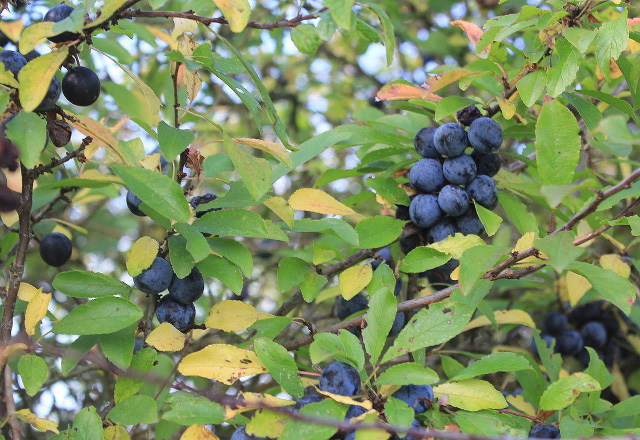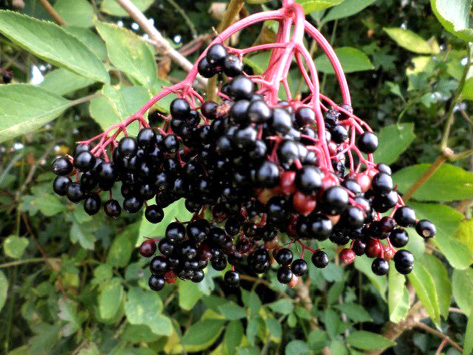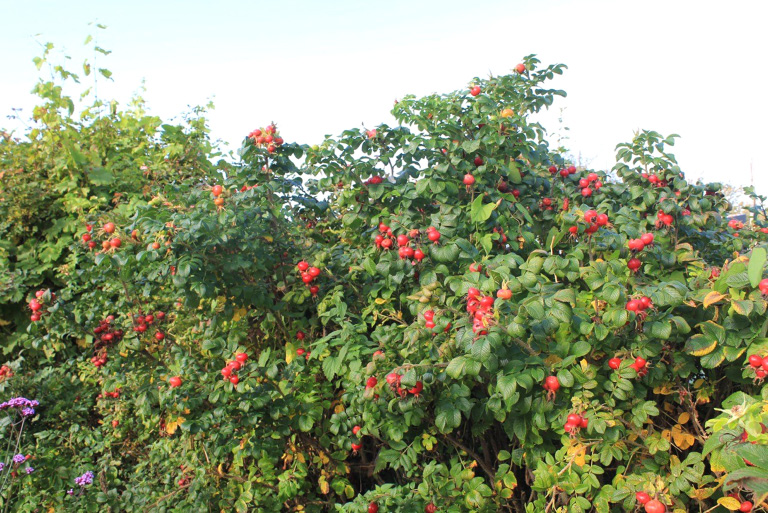The hedgerows are packed with deliciousness right now. There are elderberries for sauces and wine, rosehips for syrups and cordials, wild plums, apples, cobnuts and sloes. A veritable forager’s feast awaits at the edges of fields and roadways and it can be great fun heading out to harvest free food, giving added purpose to autumn walks and satisfying our inner hunter-gatherer. If you would like all the joys of a hedgerow harvest without the muddy trek out into the fields, or a hedge with added purpose, why not grow one of your own?
Vertical allotments
When is a hedge not a hedge? When it’s a vertical allotment! If you haven’t got room for a fruit or vegetable garden, growing upwards, rather than outwards could be the solution. Choose the right plants – apples, pears, plums and blackberries and you could even grow a linear orchard. Most of these are trees, but they can be pruned to become more of a hedge and will stay fairly neat and well behaved – as long as you keep them regularly pruned.
Go nuts
Hazels and filberts (collectively known as cobnuts) can be grown as part of a mixed hedge, or on their own as more of a nuttery. An additional benefit to the nuts are the nice straight stems that grow when hazel is coppiced. These provide sturdy plant supports, wigwams or bean poles in the vegetable garden. Hazel within a mixed native hedge will also help to support local wildlife (unfortunately this does include hungry squirrels), as nuts are packed full of nutritious fat and protein, ripening in the autumn just before creatures such as dormice go into hibernation. Cobnuts provide a valuable source of high energy food to help them get through the winter.
Sloe, sloe, quick-quick sloe
If you want to establish a fast-growing hedge, then blackthorn (sloes are the fruit), or hawthorn – commonly called quickthorn – will rapidly establish and knit together into a thorny barrier. Both hawberries and sloes are edible. It is a bit of a process making the haws edible (they seem to be stuffed with sawdust and need much straining through muslin), but sloes slip easily into gin… (see recipe below).
Gather ye rosehips
The rose blossom and hips we see in country hedges are usually those of Rosa canina, the dog rose, a climbing species that scrambles its way through our hedgerows. It has dainty single blooms in white or pale pink and scarlet hips follow on the arching stems and persist well into the winter. Rosa rugosa is a species bush rose and makes an excellent hedge on its own, or as part of a mixed hedge. It is vigorous and needs a firm hand – prune hard in February and remove any suckers that pop up over the growing season. This rose is available with flowers of white or pink, but it really comes into its own in the autumn, when the huge hips, like cherry tomatoes, are set off by the buttery yellow autumn foliage. Rose hips are packed full of vitamin C and make a lovely cordial or sauce for puddings and ice-cream, but need a fair amount of macerating and straining (they’re not quite as bad as the itchy hawberries) due to the quantity of pips.
Wildlife corridors
Woodlands and hedgerows are a vital resource for wildlife – especially as the open fields themselves are just for cultivating crops, grown as monocultures and not really nature friendly. The diversity within the hedgerow supports a wide variety of wildlife, both the living things growing within it and the habitat that exists at the base among old leaves and dead wood. A hedgerow provides a natural corridor for the wildlife to travel along, providing cover and a connection between different areas. As hedgerows continue to decline though intensive farming practices, our gardens are becoming places of refuge and shelter for many wild creatures. Providing them with the food that they naturally prefer to eat can help to sustain them.
Planting
This is the perfect time of the year for planting a deciduous hedge. It is much cheaper to buy bare-rooted plants, or whips and they will establish roots over the winter and get going quickly during the following spring. Prepare the ground well, removing weeds and grass. If the plants are bare-rooted, a sprinkling of mycorrhizae will help to feed and encourage good initial growth. Apply it directly onto the roots as you plant – it will only work effectively if the mycorrhizae are in direct contact with the roots. Plant at the recommended rate for the species and then mulch with an organic manure or spent mushroom compost – this will help to conserve moisture and prevent weed germination.
Pruning
Regular pruning will keep your hedge tidy, but a productive hedge does also need to be left to set blossom and fruit, so remember not to prune off too many flowers, or you will be cutting off future harvests. An edible hedge will never be quite as smart as a tightly clipped evergreen such as box or yew, but with the right management it will look both respectable and inviting. Winter is the best time to prune a deciduous hedge, either with a sharp pair of shears, or an electric hedge trimmer. Hedges should not be pruned during the nesting season (March-August).
Cooking your hedge
Making jams and jellies
The important thing to remember when making jam is the pectin content of the fruit. Pectin is what makes the jam set. Fruits that are high in pectin include apples, crabapples, quince, blackberries, hawthorn berries, plums. The addition of an acid, such as lemon juice will help to draw out more pectin (citrus pith also contains pectin). Setting point is reached when the jam is at the correct temperature – and kept there for 4-20 minutes (some are quicker than others). The set can be tested for by dropping a small amount onto a cooled saucer – if it wrinkles when pushed with a spoon the jam is set. The best flavours are from jams that have not been cooked too long. When you are making hedgerow jam, just match the amount of fruit – in whatever combination you like, or can find – with sugar in a ratio of 2:1 (i.e. 2 kilos of fruit to one of sugar), adding a little water if necessary.





















